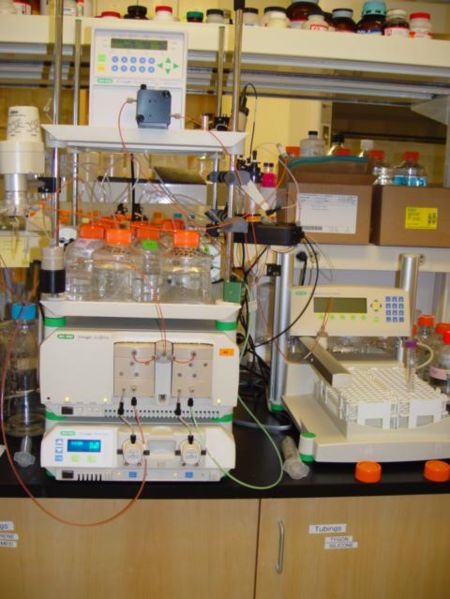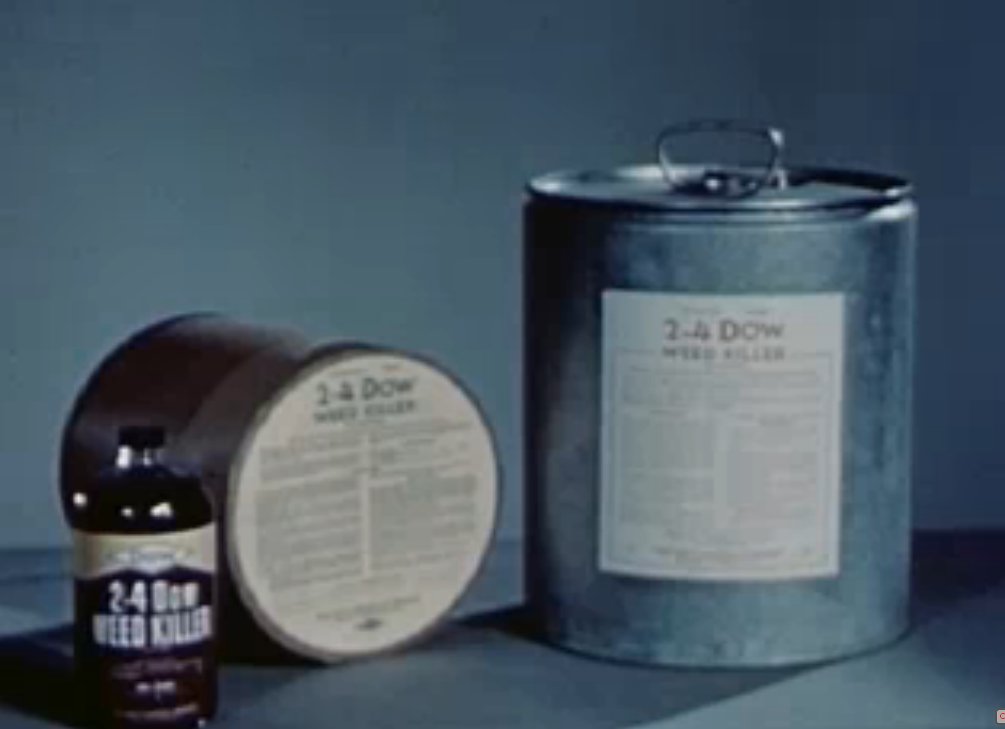|
Ammonium Sulfate
Ammonium sulfate (American English and international scientific usage; ammonium sulphate in British English); (NH4)2SO4, is an inorganic salt with a number of commercial uses. The most common use is as a soil fertilizer. It contains 21% nitrogen and 24% sulfur. Uses Agriculture The primary use of ammonium sulfate is as a fertilizer for alkaline soils. In the soil, the ammonium ion is released and forms a small amount of acid, lowering the pH balance of the soil, while contributing essential nitrogen for plant growth. One disadvantage to the use of ammonium sulfate is its low nitrogen content relative to ammonium nitrate, which elevates transportation costs. It is also used as an agricultural spray adjuvant for water-soluble insecticides, herbicides, and fungicides. There, it functions to bind iron and calcium cations that are present in both well water and plant cells. It is particularly effective as an adjuvant for 2,4-D (amine), glyphosate, and glufosinate herbicides. ... [...More Info...] [...Related Items...] OR: [Wikipedia] [Google] [Baidu] |
Ammonium Sulfate Precipitation
Ammonium sulfate precipitation is one of the most commonly used methods for large and laboratory scale protein purification and fractionation that can be used to separate proteins by altering their solubility in the presence of a high salt concentration. Properties Ammonium sulfate is an inorganic salt with a high solubility that disassociates into ammonium () and sulfate () in aqueous solutions. Ammonium sulfate is especially useful as a precipitant because it is highly soluble, stabilizes protein structure, has a relatively low density, is readily available, and is relatively inexpensive. Mechanism Ammonium sulfate, as well as other neutral salts, will stabilize proteins by preferential solvation. Proteins are usually stored in ammonium sulfate because it inhibits bacterial growth. With the addition of ammonium sulfate, proteins unfolded by denaturants can be pushed into their native conformations. This can be seen with the folding of recombinant proteins. The solubility ... [...More Info...] [...Related Items...] OR: [Wikipedia] [Google] [Baidu] |
Mascagnite
Mascagnite is a rare ammonium sulfate mineral ( N H4)2 S O4. It crystallizes in the orthorhombic system typically forming as stalactitic masses exhibiting good cleavage. It is soft (not higher than 2.5 on the Mohs scale) and water-soluble. Optical properties are variable; the purest form is transparent and colorless, but opaque gray or yellow deposits are also known. It occurs in fumaroles, as at Mount Vesuvius and associated with coal seam fire A coal-seam fire is a burning of an outcrop or underground coal seam. Most coal-seam fires exhibit smouldering combustion, particularly underground coal-seam fires, because of limited atmospheric oxygen availability. Coal-seam fire instances ...s. It was named for Italian anatomist Paolo Mascagni (1752–1815) who first described the mineral. References Ammonium minerals Sulfate minerals Orthorhombic minerals Minerals in space group 62 Mount Vesuvius {{sulfate-mineral-stub ... [...More Info...] [...Related Items...] OR: [Wikipedia] [Google] [Baidu] |
Alkaline Soil
Alkali, or alkaline, soils are clay soils with high Soil pH, pH (greater than 8.5), a poor soil structure and a low infiltration capacity. Often they have a hard calcareous layer at 0.5 to 1 metre depth. Alkali soils owe their unfavorable Physical chemistry, physico-chemical properties mainly to the dominating presence of sodium carbonate, which causes the soil to swell 16), in contact with non-saline soil moisture have an expanded DDL zone and the soil swells (dispersion (geology), dispersion). The phenomenon results in deterioration of the soil structure, and especially crust formation and compaction of the top layer. Hence the infiltration capacity of the soil and the water availability in the soil is reduced, whereas the surface-water-logging or surface runoff is increased. Seedling emergence and crop production are badly affected. :''Note'': :* Under saline conditions, the many ions in the soil solution counteract the swelling of the soil, so that saline soils usually ... [...More Info...] [...Related Items...] OR: [Wikipedia] [Google] [Baidu] |
Ionic Strength
The ionic strength of a solution is a measure of the concentration of ions in that solution. Ionic compounds, when dissolved in water, dissociate into ions. The total electrolyte concentration in solution will affect important properties such as the dissociation constant or the solubility of different salts. One of the main characteristics of a solution with dissolved ions is the ionic strength. Ionic strength can be molar (mol/L solution) or molal (mol/kg solvent) and to avoid confusion the units should be stated explicitly. The concept of ionic strength was first introduced by Lewis and Randall in 1921 while describing the activity coefficients of strong electrolytes. Quantifying ionic strength The molar ionic strength, ''I'', of a solution is a function of the concentration of ''all'' ions present in that solution. :I = \begin\frac\end\sum_^ c_i z_i^ where one half is because we are including both cations and anions, ''c''i is the molar concentration of ion i (M, mo ... [...More Info...] [...Related Items...] OR: [Wikipedia] [Google] [Baidu] |
Protein Purification
Protein purification is a series of processes intended to isolate one or a few proteins from a complex mixture, usually Cell biology, cells, Tissue (biology), tissues, or whole organisms. Protein purification is vital for the specification of the function, structure, and interactions of the protein of interest. The purification process may separate the protein and non-protein parts of the mixture, and finally separate the desired protein from all other proteins. Ideally, to study a protein of interest, it must be separated from other components of the cell so that contaminants will not interfere in the examination of the protein of interest's structure and function. Separation of one protein from all others is typically the most laborious aspect of protein purification. Separation steps usually exploit differences in protein size, physico-chemical properties, binding affinity, and biological activity. The pure result may be termed protein isolate. Purpose The protein manufacturin ... [...More Info...] [...Related Items...] OR: [Wikipedia] [Google] [Baidu] |
Glufosinate
Glufosinate (also known as phosphinothricin and often sold as an ammonium salt) is a naturally occurring broad-spectrum herbicide produced by several species of ''Streptomyces'' soil bacteria. Glufosinate is a non-selective, contact herbicide, with some systemic action. Plants may also metabolize bialaphos and phosalacine, other naturally occurring herbicides, directly into glufosinate. The compound irreversibly inhibits glutamine synthetase, an enzyme necessary for the production of glutamine and for ammonia detoxification, giving it antibacterial, antifungal and herbicidal properties. Application of glufosinate to plants leads to reduced glutamine and elevated ammonia levels in tissues, halting photosynthesis and resulting in plant death. Discovery In the 1960s and early 1970s, scientists at University of Tübingen and at the Meiji Seika Kaisha Company independently discovered that species of ''Streptomyces'' bacteria produce a tripeptide they called bialaphos that inhibits ... [...More Info...] [...Related Items...] OR: [Wikipedia] [Google] [Baidu] |
Glyphosate
Glyphosate (IUPAC name: ''N''-(phosphonomethyl)glycine) is a broad-spectrum systemic herbicide and crop desiccant. It is an organophosphorus compound, specifically a phosphonate, which acts by EPSP inhibitor, inhibiting the plant enzyme 5-enolpyruvylshikimate-3-phosphate synthase (EPSP). Glyphosate-based herbicides (GBHs) are used to kill weeds, especially annual Forbs, broadleaf weeds and grasses that compete with crops. Monsanto brought it to market for agricultural use in 1974 under the trade name Roundup (herbicide), ''Roundup''. Monsanto's last commercially relevant United States patent expired in 2000. Farmers quickly adopted glyphosate for agricultural weed control, especially after Monsanto introduced glyphosate-resistant Roundup Ready crops, enabling farmers to kill weeds without killing their crops. In 2007, glyphosate was the most used herbicide in the United States' agricultural sector and the second-most used (after 2,4-Dichlorophenoxyacetic acid, 2,4-D) in home ... [...More Info...] [...Related Items...] OR: [Wikipedia] [Google] [Baidu] |
2,4-D
2,4-Dichlorophenoxyacetic acid is an organic compound with the chemical formula . It is usually referred to by its ISO common name 2,4-D. It is a systemic herbicide that kills most broadleaf weeds by causing uncontrolled growth, but most grasses such as cereals, lawn turf, and grassland are relatively unaffected. 2,4-D is one of the oldest and most widely available herbicides and defoliants in the world, having been commercially available since 1945, and is now produced by many chemical companies since the patent on it has long since expired. It can be found in numerous commercial lawn herbicide mixtures, and is widely used as a weedkiller on cereal crops, pastures, and orchards. Over 1,500 herbicide products contain 2,4-D as an active ingredient. History 2,4-D was first reported in 1944 by Franklin D. Jones at the C. B. Dolge Company in Connecticut. The biological activity of 2,4-D as well as the similar hormone herbicides 2,4,5-T, and MCPA were discovered during World W ... [...More Info...] [...Related Items...] OR: [Wikipedia] [Google] [Baidu] |
Fungicide
Fungicides are pesticides used to kill parasitic fungi or their spores. Fungi can cause serious damage in agriculture, resulting in losses of yield and quality. Fungicides are used both in agriculture and to fight fungal infections in animals, including humans. Fungicides are also used to control oomycetes, which are not taxonomically/genetically fungi, although sharing similar methods of infecting plants. Fungicides can either be contact, translaminar or systemic. Contact fungicides are not taken up into the plant tissue and protect only the plant where the spray is deposited. Translaminar fungicides redistribute the fungicide from the upper, sprayed leaf surface to the lower, unsprayed surface. Systemic fungicides are taken up and redistributed through the xylem vessels. Few fungicides move to all parts of a plant. Some are locally systemic, and some move upward. Most fungicides that can be bought retail are sold in liquid form, the active ingredient being present at 0.08% i ... [...More Info...] [...Related Items...] OR: [Wikipedia] [Google] [Baidu] |
Herbicide
Herbicides (, ), also commonly known as weed killers, are substances used to control undesired plants, also known as weeds.EPA. February 201Pesticides Industry. Sales and Usage 2006 and 2007: Market Estimates. Summary in press releasMain page for EPA reports on pesticide use ihere Selective herbicides control specific weed species while leaving the desired crop relatively unharmed, while non-selective herbicides (sometimes called "total weed killers") kill plants indiscriminately. The combined effects of herbicides, nitrogen fertilizer, and improved cultivars has increased yields (per acre) of major crops by three to six times from 1900 to 2000. In the United States in 2012, about 91% of all herbicide usage, was determined by weight applied, in agriculture. In 2012, world pesticide expenditures totaled nearly US$24.7 billion; herbicides were about 44% of those sales and constituted the biggest portion, followed by insecticides, fungicides, and fumigants. Herbicide is also used ... [...More Info...] [...Related Items...] OR: [Wikipedia] [Google] [Baidu] |
Insecticide
Insecticides are pesticides used to kill insects. They include ovicides and larvicides used against insect eggs and larvae, respectively. The major use of insecticides is in agriculture, but they are also used in home and garden settings, industrial buildings, for vector control, and control of insect parasites of animals and humans. Acaricides, which kill mites and ticks, are not strictly insecticides, but are usually classified together with insecticides. Some insecticides (including common bug sprays) are effective against other non-insect arthropods as well, such as scorpions, spiders, etc. Insecticides are distinct from insect repellents, which repel but do not kill. Sales In 2016 insecticides were estimated to account for 18% of worldwide pesticide sales. Worldwide sales of insecticides in 2018 were estimated as $ 18.4 billion, of which 25% were neonicotinoids, 17% were pyrethroids, 13% were diamides, and the rest were many other classes which sold for less th ... [...More Info...] [...Related Items...] OR: [Wikipedia] [Google] [Baidu] |
Adjuvant
In pharmacology, an adjuvant is a drug or other substance, or a combination of substances, that is used to increase the efficacy or potency of certain drugs. Specifically, the term can refer to: * Adjuvant therapy in cancer management * Analgesic adjuvant in pain management * Immunologic adjuvant In immunology, an adjuvant is a substance that increases or modulates the immune response to a vaccine. The word "adjuvant" comes from the Latin word , meaning to help or aid. "An immunologic adjuvant is defined as any substance that acts to acce ... in vaccines {{sia Adjuvants ... [...More Info...] [...Related Items...] OR: [Wikipedia] [Google] [Baidu] |



